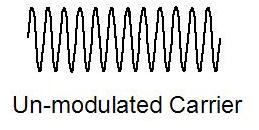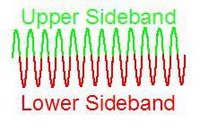
So, now we know how to generate a continuous electromagnetic wave and that if we interrupt the wave we can send signals. But we want to be able to talk.
Another pretty bright guy discovered that if you put direct current through a bunch of very fine, compressed carbon granules and then yelled at the whole thing, you could make the direct current change its amplitude (or its “height”) in relation to the words you yelled. That is, with no noise there was no variation in the DC.

When one yelled, the carbon compressed and caused a change in its electrical resistance so that the power in the DC current varied with the speech. Now we could talk. Simple huh? Well it many years to go from that simple experiment to speech over radio. But that was the beginning. Eventually someone discovered how to change the amplitude of the Continuous Wave Electromagnetic field according to the variations in resistance of that carbon thinggie.... which they called a carbon microphone.
Varying some characteristic of an electronic circuit is called modulation. Because we were now able to vary or modulate the amplitude of the electromagnet wave, it was called Amplitude Modulation or AM. So first CW, then AM.
Well by this time people were yacking all around the world. People had radios in cars, the cops (and crooks) had two way radios and a bunch of geeikie folks had formed a hobby called Amateur Radio. For some unknown reason they were called Hams. So all was well .......except...
Lightning is amplitude modulated.
So right in the middle of the nice music, or the important message, the listener would hear a VERY LOUD NOISE. In fact, my hearing was pretty much destroyed by listening to AM radio during storms. I was an Air Traffic Controller. I talked aircraft down during storms using a very complex radar system and AM radio. Of course we did it mostly during electrical storms.
Then somebody had another idea. Suppose we keep the amplitude constant, and modulate the frequency. It worked. By shifting the frequency just a bit in relation to the electrical current generated by a microphone, it became possible to transmit speech by a method that did not hear the amplitude modulated thunder noise. It was of course called Frequency Modulation, or FM. So now we have CW, AM and FM. Pick a nice stormy night and listen to some AM radio, then switch to a FM station. Notice the difference? Very little noise is present in the FM station.

During World War 2, we tried to get every bit of range out of the radios. Somebody noticed that an AM radio signal was symmetrical. That is, the wave gained in amplitude to a maximum, then dropped to zero, then went negative to a minimum then back to zero. The positive half was exactly like the negative half, just in the opposite direction.

So, why send both the top and the bottom? If you just send the top part, you can create the identical but negative part in the receiver. Just send one “sideband”. It worked.

So now all the energy needed to send both sidebands was concentrated is a single sideband with the missing sideband being generated at the receiver. It, of course, was called Single Side Band or SSB. One could send either the upper or lower side band. It has the advantage of being much more efficient than either AM or FM, actually more efficient than even CW. But it has all the noise disadvantages of AM. Mostly SSB is used for voice and data communications.





OK, so now we have CW, AM, FM and Upper and Lower SSB. And you understand them all. Good job.
So here they all are. There are other methods, but they are beyond the scope of this document.
So here they all are. There are other methods, but they are beyond the scope of this document.
So what does all this mean to us? Well, CB is AM so you get a lot of noise. Its frequency (26 MHz) is one that bends around the earth and under the right circumstances will go thousands of miles. So when the band is open, the electromagnetic wave is propagating for thousands of miles, you get to hear hundreds of signals (called skip) and much noise all at the same time.
Remember that MHz = Millions of hertz. So what'sa Hertz?
The hertz (symbol: Hz) is the unit of frequency. It is named in honor of the German physicist Heinrich Rudolf Herz, who made important scientific contributions to electromagnetism. In English, "hertz" is used in both singular and plural. (From Wikipedia, the free encyclopedia)
So, 150 MHz = 150,000,000 cycles (Hertz) per second
The approximate frequencies in common use for;
Public Service (Police, fire, Ambulanec etc.) = 150, 470 & 800 MHz,
FRS (Family Radio Service) = 460 MHz
GMRS (General Mobile Radio Service0 = 460 MHz
VHF Amateur =146 MHz
UHF Amateur = 440 MHz
These frequencies are "high" enough so their range is limited to Line of Sight which makes them mostly immune to skip, and they are FM, so they are quiet.
So what is this Line of Sight thing? That's next.
So what is this Line of Sight thing? That's next.
No comments:
Post a Comment